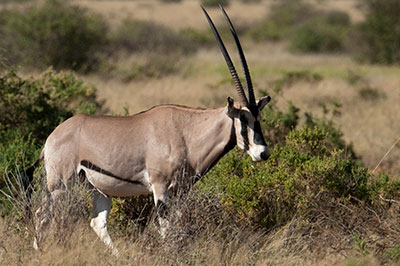It is hot, dry and somewhat out of the way, but Samburu National Reserve is the most popular park in northern Kenya. It is 165 km in size and geographically located in Samburu County. Those discouraging features just might be the secret to its attraction. In a rugged area known for its desert-like climate, the animals of the park are sure to frequent its main source of water – the Ewaso Ng’iro River.
And as a visitor, you are certain to witness this abundant display of wildlife, regularly sustaining itself at the river. This reserve has its share of the big cats – lion, leopard and cheetah. And you’ll find many of the larger grazers here like impala, buffalo and hippo.



Elephants? Samburu boasts over 900 of these peaceful creatures… the herds gathering at the life sustaining river. Meanwhile beneath the river’s muddy brown waters, a significant population of Nile crocodile can be spotted, waiting for their prey.
With a distinct isolated beauty of the dry North, the National reserves of Samburu, Shaba and Buffalo Springs, are heavy with classic big game, termite skyscrapers host a population of creatures that occur in no other major Kenyan Park. A visit to the reserve will bring you in sight of such memorable species as Grevy’s Zebra, blue-leered Somali Ostrich, the gerenuk, the reticulated giraffe and the Beisa onyx. And this is one of the few parks where you have a good chance of spotting African wild dogs.
For bird lovers the reserve presents a constant display of exciting avian life – over 450 species. On game drives over the savannah, through acacia forest and riverine vegetation there will be numerous opportunities to view kingfishers, marabous, vultures, guinea fowl, Somali ostrich, egret, flocks of vulturine, marshal and helmeted eagles and falcon. But despite the active wildlife here, the reserve gives off a sense of tranquility and a peaceful feeling. Some attribute this to the fact that Samburu is relatively remote and initially was inaccessible as other parks developed.
It is also a land of magical possibilities – this was one of two regions in which Joy Adamson raised and nurtured Elsa the lioness, whose story was told in the book and movie, “Born Free”. Samburu was also home to another renowned lioness, Kamunyak (“Blessed One”) who is famous for having adopted at least 6 oryx calves. She fought off predators to save her young orphans as seen in the film, “Heart of a Lioness”. Named for the indigenous Samburu people, whose villages border the reserve. The local populations of the neighboring communities are of the Rendille, Borana and the Samburu tribe, a descendent clan of the Masai.
Cattle, as well as sheep, goats and camels, are of utmost importance to the Samburu culture and way of life. The Samburu paint their faces using striking patterns to accentuate their facial features & neighboring tribes, admiring the beauty of the Samburu people, called them “Samburu” which means butterfly. Activities include cultural tours with the local Samburu tribe, in which one can have a cultural experience with traditional food and dancing. There are also game drives, guided walks, mountain biking, big cat tracking, camelback safaris and bush breakfasts.







